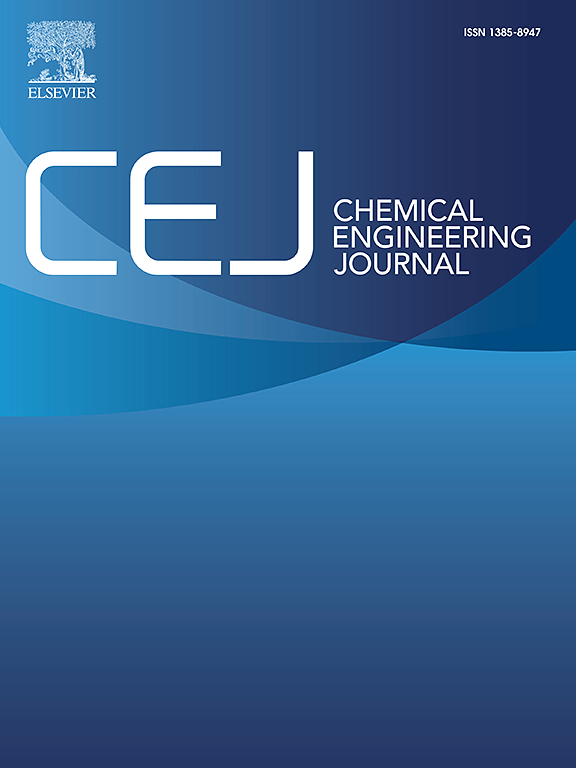Fe sites engineering unlocks selective chemiresistive sensing of n-propanol for breath-based lung cancer diagnostics
IF 13.2
1区 工程技术
Q1 ENGINEERING, CHEMICAL
引用次数: 0
Abstract
Developing sensitive and cost-effective gas sensors for exhaled volatile organic compounds (VOCs) like n-propanol, a potential lung cancer biomarker, is challenging due to their low concentrations and the complex composition of in breath. While metal oxide semiconductors (MOS) like SnO2 are stable and affordable, their limited sensitivity and poor selectivity hinder reliable sub-ppm VOCs detection. Here, we report a Fe sites-engineered SnO2 nanoflowers (Fe-SnO2 NFs) synthesized via self-templated pyrolysis strategy, overcoming limitations by optimizing its structural and electronic properties. Fe sites-engineering boosts surface reactivity and charge transport, enhancing selective n-propanol sensing. The Fe-SnO2 NFs based sensor exhibits excellent sensing performance, with a response ratio of 1.9 at 5 ppb n-propanol, along with remarkable repeatability and long-term stability. Mechanistic insights indicate that Fe sites function as selective adsorption centers for n-propanol and concurrently boost the adsorption efficiency of neighboring Sn sites. Meanwhile, the hierarchical nanoflower architecture promotes efficient gas diffusion and intensified surface interactions. Moreover, validated using simulated exhaled breath samples, this work establishes Fe-SnO2 NFs as a transformative platform for non-invasive, point-of-care lung cancer screening, bridging material innovation with clinical diagnostic needs.


铁位点工程解锁选择性化学感应正丙醇呼吸为基础的肺癌诊断
正丙醇是一种潜在的肺癌生物标志物,由于其浓度低且成分复杂,因此为呼出的挥发性有机化合物(VOCs)开发敏感且具有成本效益的气体传感器具有挑战性。虽然像SnO2这样的金属氧化物半导体(MOS)稳定且价格合理,但它们有限的灵敏度和较差的选择性阻碍了可靠的ppm以下VOCs检测。本文报道了一种Fe-SnO2纳米花(Fe-SnO2 NFs)通过自模板热解策略合成,通过优化其结构和电子性能克服了局限性。铁位点工程提高表面反应性和电荷传输,增强选择性正丙醇传感。基于Fe-SnO2 NFs的传感器具有优异的传感性能,在5 ppb正丙醇下的响应比为1.9,具有良好的重复性和长期稳定性。机制分析表明,Fe位点作为正丙醇的选择性吸附中心,同时提高了相邻Sn位点的吸附效率。同时,层次化的纳米花结构促进了高效的气体扩散和强化的表面相互作用。此外,通过模拟呼出样本的验证,本研究将Fe-SnO2 NFs建立为无创、即时肺癌筛查的变革性平台,将材料创新与临床诊断需求联系起来。
本文章由计算机程序翻译,如有差异,请以英文原文为准。
求助全文
约1分钟内获得全文
求助全文
来源期刊

Chemical Engineering Journal
工程技术-工程:化工
CiteScore
21.70
自引率
9.30%
发文量
6781
审稿时长
2.4 months
期刊介绍:
The Chemical Engineering Journal is an international research journal that invites contributions of original and novel fundamental research. It aims to provide an international platform for presenting original fundamental research, interpretative reviews, and discussions on new developments in chemical engineering. The journal welcomes papers that describe novel theory and its practical application, as well as those that demonstrate the transfer of techniques from other disciplines. It also welcomes reports on carefully conducted experimental work that is soundly interpreted. The main focus of the journal is on original and rigorous research results that have broad significance. The Catalysis section within the Chemical Engineering Journal focuses specifically on Experimental and Theoretical studies in the fields of heterogeneous catalysis, molecular catalysis, and biocatalysis. These studies have industrial impact on various sectors such as chemicals, energy, materials, foods, healthcare, and environmental protection.
 求助内容:
求助内容: 应助结果提醒方式:
应助结果提醒方式:


